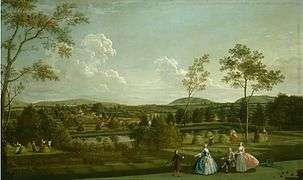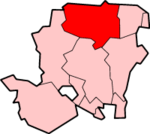Newtown, Hampshire
| Newtown, Hampshire | |
 Newtown Church |
|
 Newtown, Hampshire |
|
| District | Basingstoke and Deane |
|---|---|
| Shire county | Hampshire |
| Region | South East |
| Country | England |
| Sovereign state | United Kingdom |
| Post town | NEWBURY |
| Postcode district | RG20 |
| Dialling code | 01635 |
| Police | Hampshire |
| Fire | Hampshire |
| Ambulance | South Central |
| EU Parliament | South East England |
| UK Parliament | North West Hampshire |
Coordinates: 51°22′21″N 1°19′04″W / 51.3724°N 1.3177°WNewtown is a village and civil parish in the English county of Hampshire, located just south of Newbury.
History
Between 1200 and 1255 the Bishops of Winchester created six new towns; Newtown, Overton, Hampshire, Hindon, Newtown, Isle of Wight, New Alresford and Downton, Wiltshire.[1] The medieval borough of Newtown was formed from part of the parish of Burghclere, and flourished in the 13th and 14th centuries. Adjacent Sandleford Priory, Sandleford, over the border on the other side of the river Enborne (Alder stream) in Berkshire, had been founded on an earlier establishment between 1193 and 1202. Newtown as a result it was sometimes known as Novus Burgus de Clere, or Nova villa de Sandelford. In 1218, the grant of a market and a fair at Newtown was made to the Bishop of Winchester (at the time Peter des Roches) and in the bishop's account roll of 1218–19 fifty-two burgesses are listed. The burgesses occupied sixty-seven plots of land in the new borough. The Prior of Sandleford bought three plots. Also in 1218–19, a chapel was built for the local people of the new borough, and was originally known as the Chapel of Sandleford.
In 1224–25, a ditch was dug around the town at the bishop's expense and, in 1225–26, the bishop's own house was built in the borough. By the 16th century, the town had begun to decay, although the reason for its decline is not known, and, in 1674, only sixty-four houses remained, probably scattered throughout the parish. No traces of the medieval borough can be seen above ground today.
Governance


The village of Newtown is part of the civil parish of Newtown,[3] and is part of the Burghclere, Highclere and St. Mary Bourne ward of Basingstoke and Deane borough council.[4] The borough council is a Non-metropolitan district of Hampshire County Council.
Religious sites
The Church of England parish church of St Mary and St John the Baptist was built in 1865 on the site of the original medieval chapel. The building was financed entirely by Edmund (1793–1873) and Elizabeth Arbuthnot (died 1866). Eliza Arbuthnot's brother William Pollet Brown Chatteris (1810–1889), JP, DL, had taken on the lease of neighbouring Sandleford in 1831 and then bought it outright in 1875. The church is filled with stained glass windows in their collective memory. Edmund Arbuthnot had bought Newtown House in 1824.
Industry
Butchers, bakers, ironmongers and shoemakers were listed in the old borough records, but more recently the parish has been famed locally for making wooden rakes.
Famous people
- Peter des Roches, the Bishop of Winchester who founded Newtown;
- Mrs. Montagu of Sandleford, her favourite view from her priory was looking south from her terrace towards Newtown, as recorded by Edward Haytley, circa 1744,and in her letters;
- Vice Admiral George Darby (c.1720 – 1790), of Newtown House; commander-in-chief of the Western squadron 1780-2; M.P. for Plymouth, 1780–1784;[5] Lord of the Admiralty (one of the Lords Commissioners of the Admiralty) 1780 – March 1782;[6]
- Major-General Matthew Chitty Darby-Griffith (born Hampshire, 1771/72 – 1821/23),[7] the second son of Vice Admiral George Darby by his wife, Mary, daughter of Sir William St Quintin, 4th Baronet.[8][9]
- Rt. Rev. Dr. Richard Pococke, of Newtown House, Bishop of Meath. He was a grandson of Rev. Isaac Milles, of Highclere.[10]
- Eustace Roskill, Baron Roskill, Lord of Appeal in Ordinary;
- Tristan de Vere Cole, producer of TV's Z Cars, set in a mythical Newtown;
Literature
%2C_Wood_gatherers%2C_looking_south%2C_with_Highclere_Castle%2C_Hampshire%2C_in_the_distance%2C_1805.jpg)
Newtown churchyard and Newtown Common both feature in Richard Adams' novel, Watership Down.
Mrs Elizabeth Montagu's 1743 description of Newtown
In 1743 Mrs Montagu wrote from Sandleford to her old friend the Duchess of Portland and described her new retreat:
'...I had a very pleasant journey to this place [Sandleford], where I am delighted to find everything that is capable of making retreat agreeable; the garden commands a fine prospect, the most cheerful I ever saw, and not of shirt distance which is only to gratify the pride of seeing, but such as falls within the humble reach of my eyes. We have a pretty village [Newtown] on a rising ground just before us.'
Where the cottage chimney smokes,
Fast between two oaks.[11]
'Poverty here is clad in its decent garb of low simplicity, but her tattered robes of misery do not here show want and wretchedness; you would rather imagine pomp was neglected than sufficiency wanted.'
'A silver stream [the Alder stream, aka river Enborne] washes the foot of the village [Newtown]; health, pleasure, and refreshment are the ingredients that qualify this spring; no debauch, or intoxication, arises from its source.'
'Nature has been very indulgent to this country, and has given it enough of wood and water; the first we have here in good plenty, and a power of having more of the latter, as improvements are undertaken.'
'Here are temptations to riding and walking. I go out every evening to take a view of the country; the villages are the neatest I ever saw; every cottage is tight; has a little garden, and is sheltered by fine trees...'[12]
References
- ↑ Maurice W. Beresford, in Time and Place, collected essays, Hambledon Press, 1985, 'The Six New Towns of the Bishops of Winchester, 1200–1255', pages 47–76.
- ↑ Tours in Scotland: 1747, 1750, 1760, by Richard Pococke, edited with a biographical sketch by Daniel William Kemp, Edinburgh, 1887. His will published on page lxiii.
- ↑ "Hampshire County Council's legal record of public rights of way in Hampshire" (PDF). 2008. Retrieved 26 October 2010.
- ↑ "Basingstoke and Deane Wards info". 2010. Retrieved 26 October 2010.
- ↑ politically bound to Lord Sandwich
- ↑ I. R. Christie in The History of Parliament: the House of Commons 1754–1790, ed. L. Namier, J. Brooke., 1964
- ↑ Captain & Lieutenant-Colonel 3 July 1801; served in Peninsula with 1/1st Foot Guards (1st Regiment of Foot Guards (Grenadier Guards from July 1815) October 1808 to January 1809; brevet Colonel 25 July 1810; again in Peninsula with 3/1st Foot Guards April to July 1811; commanded 1/1st Foot Guards in Peninsula September 1812 to June 1813; Major-General 4 June 1813;
- ↑ His maternal aunt was Mrs. Catherine Griffith, the wife of Christopher Griffith Esq., from whom he inherited the Padworth estate in September 1801. In accordance with her will, he also took the additional name of Griffith.
- ↑ A new and accurate description of all the direct and principal cross roads in Great Britain, by Daniel Paterson, 1803.
- ↑ Tours in Scotland: 1747, 1750, 1760, by Richard Pococke, edited with a biographical sketch by Daniel William Kemp, Edinburgh, 1887. His will published on page lxiii.
- ↑ From John Milton's 'L'allegro', 'Hard by, a cottage chimney smokes, From betwixt two aged oaks,'
- ↑ The Letters of Mrs. Elizabeth Montagu, edited by her nephew Matthew Montagu, MP, London, 1809.
External links
![]() Media related to Newtown, Hampshire at Wikimedia Commons
Media related to Newtown, Hampshire at Wikimedia Commons
